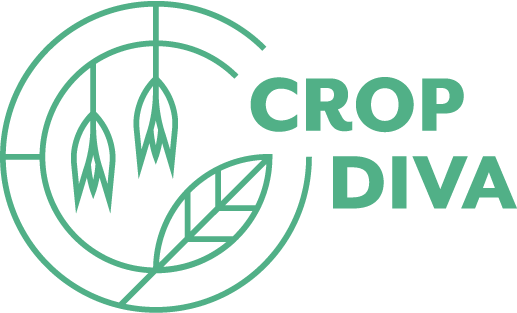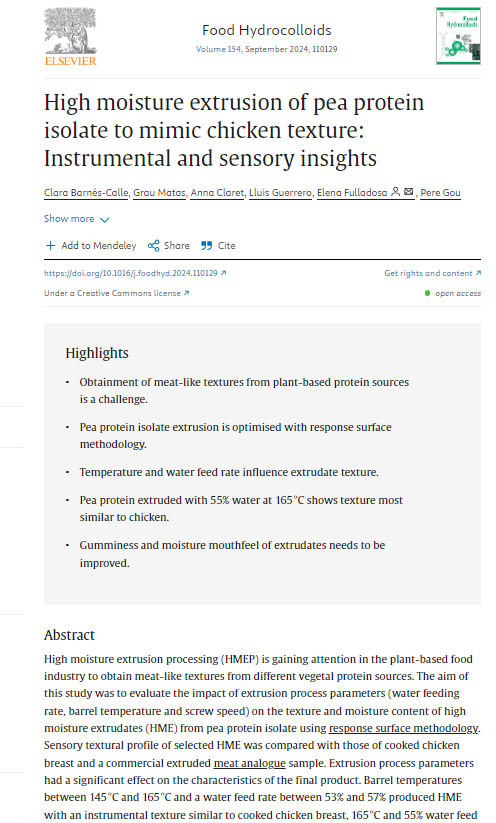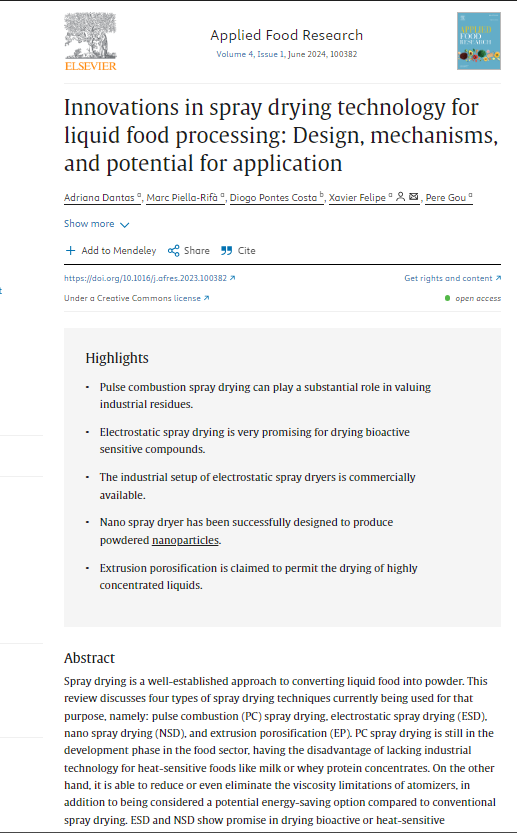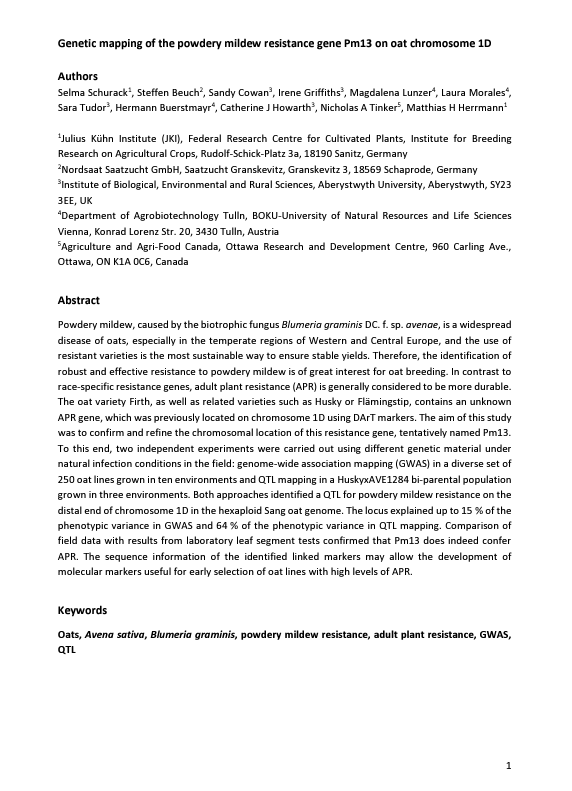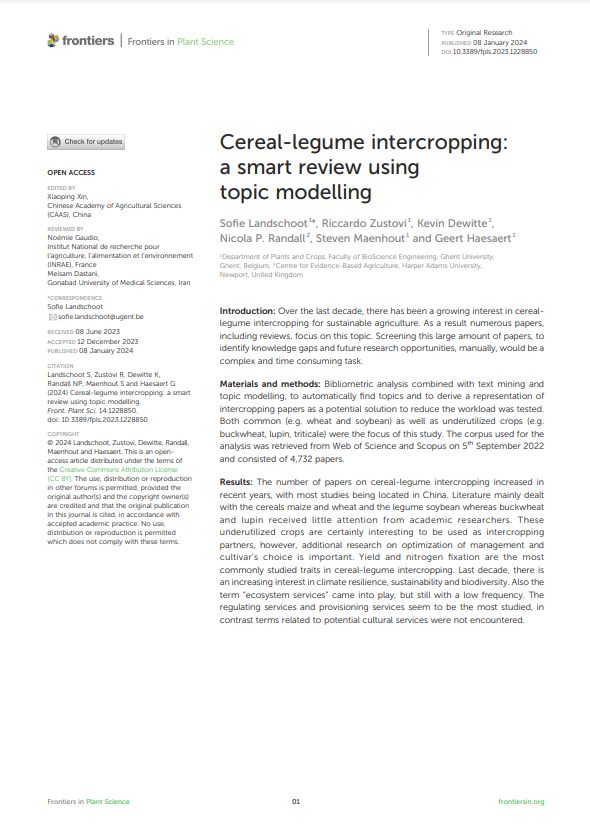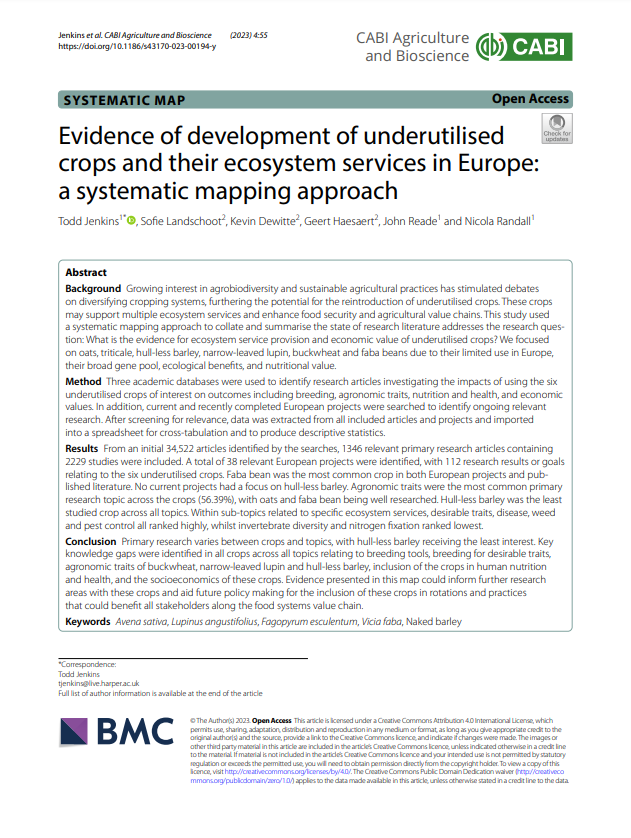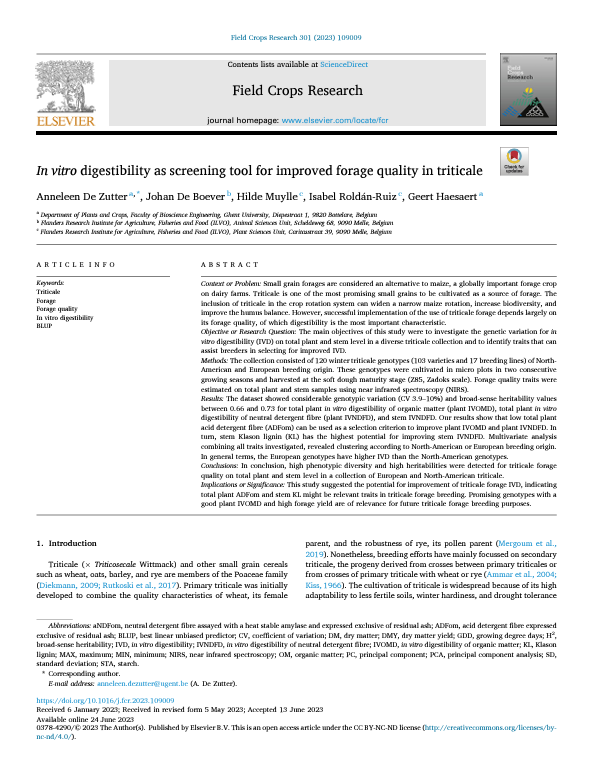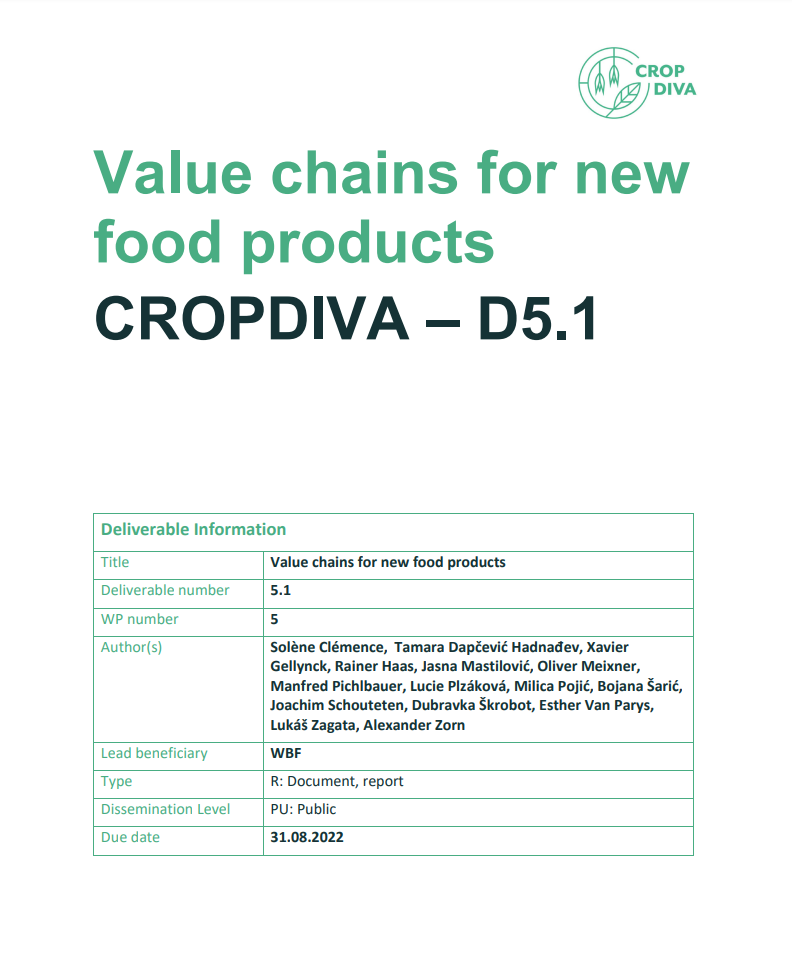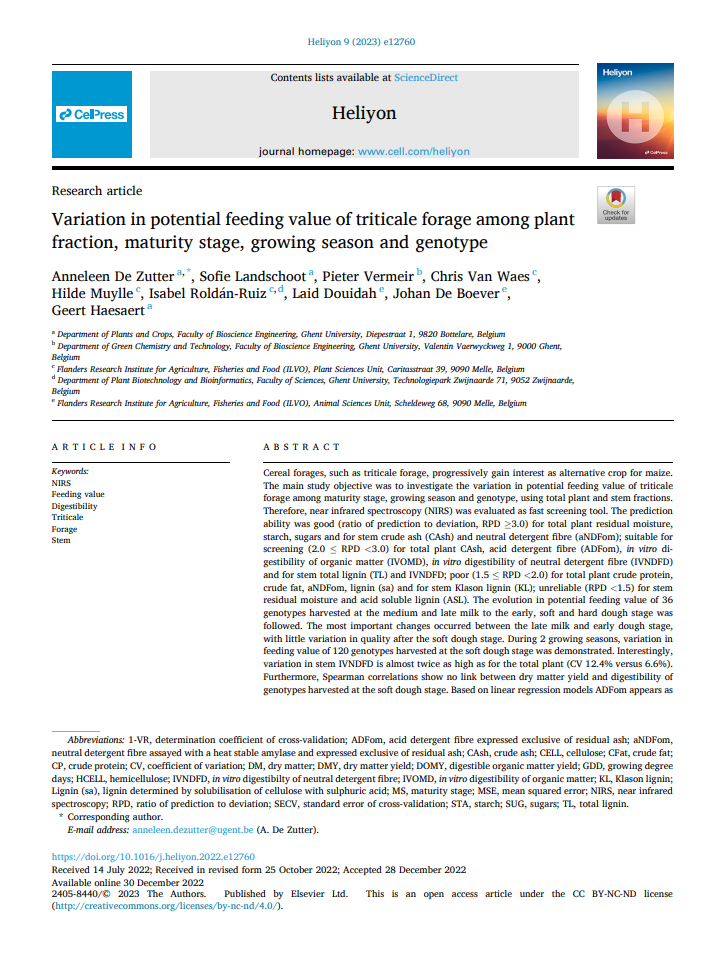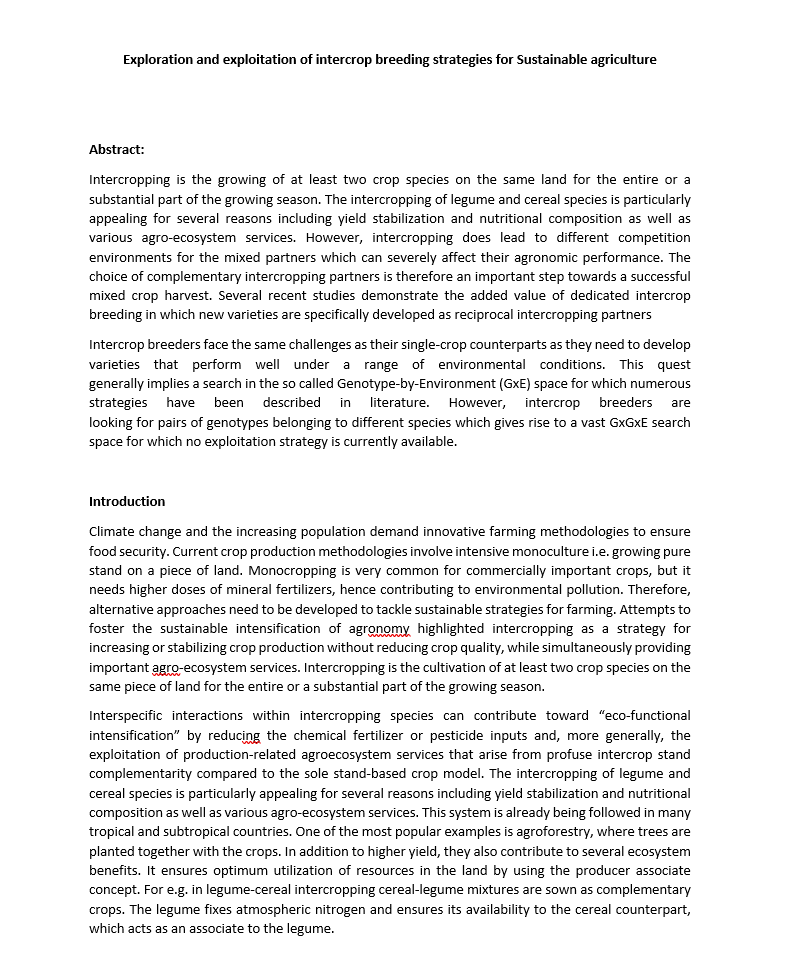Articles
Scientific article. High moisture extrusion of pea protein isolate to mimic chicken texture: Instrumental and sensory insights
(Clara Barnés-Calle, Grau Matas, Anna Claret, Lluis Guerrero, Elena Fulladosa, Pere Gou)
High-moisture extrusion processing (HMEP) is being explored in the plant-based food industry to create meat-like textures from vegetable proteins like pea protein isolate. This study assessed how extrusion parameters - water feed rate, barrel temperature and screw speed - affect the texture and moisture content of high moisture extrudates (HME) using response surface methodology.
Scientific article. Innovations in spray drying technology for liquid food processing: Design, mechanisms and potential for application
(Adriana Dantas, Marc Piella-Rifà, Diogo Pontes Costa, Xavier Felipe, Pere Gou)
Spray drying is a method used to convert liquid food into powder. Four techniques are currently under investigation: pulse combustion (PC), electrostatic spray drying (ESD), nano spray drying (NSD) and extrusion porosification (EP). PC spray drying is still developing for the food industry but may offer energy savings, while ESD and NSD are suitable for drying sensitive bioactive compounds but are limited to laboratory-scale equipent. EP can improve powder characteristics and handle highly concentrated liquids, with potential for future advancemetns in food processing.
Scientific article. Genetic mapping of the powdery mildew resistance gene Pm13 on oat chromosome 1D
(Selma Schurack, Steffen Beuch, Sandy Cowan, Irene Griffiths, Magdalena Lunzer, Laura Morales, Sara Tudor, Hermann Buerstmayr, Catherine J Howarth, Nicholas A Tinker, Matthias H Herrmann)
Powdery mildew is a common oat disease in temperate Europe, and using resistant varietis is the most sustainable control method. This study aimed to confirm the location of an adult plant resistance gene, tentatively named Pm13, previously found on chromosome 1D in oat varieties like Firth. Through genome-wide association and QTL mapping, the resistance gene was confirmed on the distal end of chromosome 1D, and linked markers were identified that could aid in breeding for mildew-resistant oat varieties.
Scientific article. Cereal-legume intercropping: a smart review using topic modelling
(Sofie Landschoot, Riccardo Zustovi, Kevin Dewitte, Nicola P. Randall, Steven Maenhout & Geert Haesaert)
Interest in cereal-legume intercropping for sustainable agriculture has increased over the past decade, making it challenging to manually identify research gaps from numerous studies. A bibliometric analysis with text mining and topic modeling was used to analyse 4732 papers, focusing on common (wheat, soybean) and underutilized crops (buckwheat, lupin, triticale).
Scientific article. Intercropping indices evaluation on grain legume-small grain cereals mixture: a critical meta-analysis review
(Riccardo Zustovi, Sofie Landschoot, Kevin Dewitte, Greet Verlinden, Reena Dubey, Steven Maenhout & Geert Haesaert)
Intercropping has gained significant scientific attention since the mid-1900s, leading to the development of over 20 indices to evaluate its performance. This review assesses these indices using a meta-dataset from various intercropping experiments. The study finds that many indices fail to capture the full system performance and suggests a standardized protocol for better evaluation and optimization.
Scientific article. Evidence of development of underutilised crops and their ecosystem services in Eurpe: a systematic mapping approach
(Todd Jenkins, Sofie Landschoot, Kevin Dewitte, Geert Haesaert, John Reade & Nicola Randall)
Interest in agrobiodiversity has led to discussions on using underutilized crops like oats, triticale, hull-less barley, narrow-leaved lupin, buckwheat, and faba beans. A study reviewed research on their ecosystem services and economic value, finding faba beans well-studied and hull-less barley the least. Identified gaps in breeding, agronomic traits, and socioeconomics suggest directions for future research and policy to integrate these crops into sustainable agriculture.
Scientific article. Exploration and exploitation of the GxGxE space spanned by multi-environment intercropping experiments
(Reena Dubey, Steven Maenhout Progeno, Technologiepark-Zwijnaarde 82, 9052 Gent, Predictive breeding, Ghent University, Belgium)
Due to operational constraints, existing breeding strategies generally allow exploring a limited part of the GxGXE interaction space in an intercropping system. In this project, we try to develop specialized breeding methods for intercrops, harnessing ecophysiological crop modelling along with traditional monocrop breeding appraoches.
Scientific article. The Potential of Small Landscape Features to Increase Biodiversity and Ecosystem Services in Arable Farmland
(Todd Jenkins, Dr. John Reade, Dr. Nicola Randall — Harper Adams University, Shropshire, TF10 8NB UK)
The findings in this study support the use of multifunctional, annual mixes as a potential option for farmers, as they offer a range of ecosystem services. The study also indicates that there is no trade-off when using mixes that target multiple ecosystem services, compared to those that focus on a single service.
Scientific article. Potential use of faba bean (vicia faba l.) in creation of plant based spreads.
(Dubravka ŠKROBOT, Milica POJIĆ, Jelena TOMIĆ, Predrag IKONIĆ, Miloš ŽUPANJAC, Vojislav BANJAC, Mladenka PESTORIĆ, University of Novi Sad, Institute of Food Technology, Bulevar cara Lazara 1, 21000 Novi Sad, Serbia)
Despite the widespread use of faba bean in the past, it's currently a rather marginal and underutilized crop that represents a niche retail product. The current popularity of meat alternatives offers growth potential. The objective of this study was to formulate, produce and characterize the functional spreads processed out of faba bean seeds, as an alternative to classical meat/liver pâté.
Scientific article. Identification, High-Density Mapping and Characterization of New Major Powdery Mildew Resistance Loci From the Emmer Wheat Landrace
(Zuzana Korchanová, Miroslav Svec, Eva Janáková, Adam Lapar, Maciej Majka, Katerina Holusová, Georgi Bonchev, Jakub Juracka, Petr Cápal, Miroslav Valárik )
Powdery mildew is one of the most devastating diseases of wheat which significantly decreases yield and quality. Identification of new sources of resistance and their implementation in breeding programs is the most effective way of disease control. Two major powdery mildew resistance loci conferring resistance to all races in seedling and adult plant stages were identified in the emmer wheat landrace GZ1.
Scientific article. In vitro digestibility as screening tool for improved forage quality in triticale
(Anneleen De Zutter, Johan De Boever, Hilde Muylle, Isabel Roldán-Ruiz, Geert Haesaert)
Small grain forages are considered an alternative to maize.Triticale is one of the most promising small grains to be cultivated as a source of forage. The inclusion of triticale in the crop rotation system can widen a narrow maize rotation, increase biodiversity, and improve the humus balance.This study suggested the potential for improvement of triticale forage IVD, indicating total plant ADFom and stem KL might be relevant traits in triticale forage breeding. Promising genotypes with a good plant IVOMD and high forage yield are of relevance for future triticale forage breeding purposes.
Article. From Niche Crop to Mainstream Success
(Clémence S., Zorn A.)
Starting in 2023, the Swiss Confederation intends to promote the cultivation of grain legumes. This could have a positive impact on the cultivation of these niche crops. However, further measures are needed if we want to see these and other rarely grown crops on consumers’ dinner plates. For this reason, Agroscope experts looked at the entire value chains of oats, triticale, faba beans and lupin. Findings are based on interviews with the relevant stakeholders: breeders and researchers, growers, the processing industry and the retail market.
Scientific Article. Variation in potential feeding value of triticale forage among plant fraction, maturity stage, growing season and genotype
(Anneleen De Zutter, Sofie Landschoot, Pieter Vermeir, Chris Van Waes, Hilde Muylle, Isabel Roldán-Ruiz, Laid Douidah, Johan De Boever, Geert Haesaert)
Cereal forages, such as triticale forage, progressively gain interest as alternative crop for maize. The main study objective was to investigate the variation in potential feeding value of triticale forage among maturity stage, growing season and genotype, using total plant and stem fractions. Therefore, near infrared spectroscopy (NIRS) was evaluated as fast screening tool.
Scientific article. Exploration and exploitation of intercrop breeding strategies for Sustainable Agriculture
(Reena Dubey)
Intercrop breeders face the same challenges as their single-crop counterparts as they need to develop varieties that perform well under a range of environmental conditions. This quest generally implies a search in the so called Genotype-by-Environment (GxE) space for which numerous strategies have been described in literature. However, intercrop breeders are looking for pairs of genotypes belonging to different species which gives rise to a vast GxGxE search space for which no exploitation strategy is currently available. This PhD research project aims to develop dedicated data analysis methods that allow for an efficient exploitation of an intercrop GxGxE space.
